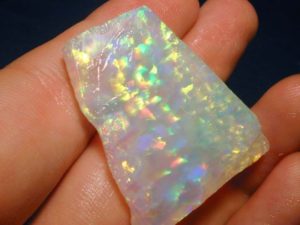FAQ : How can I tell if an opal is real? What is Gilson opal? What are synthetic opals? How can I tell if an opal is synthetic? What is synthetic opal? How can I identify opals? Is my opal real?
HOW TO TELL IF AN OPAL IS REAL
FAQ : How can I tell if an opal is real? What is Gilson opal? What are synthetic opals? How can I tell if an opal is synthetic? What is synthetic opal? How can I identify opals? Is my opal real?
SYNTHETIC OPAL, DOUBLETS & TRIPLETS
Have you ever pondered if you’re getting what you paid for? Well, hold onto your curiosity hats, because synthetic opals are a real thing. Plus, there’s a bunch of partially man-made options like triplets and doublets out there. In this article, we’re here to give you the inside scoop on how to be crystal clear about what exactly you’re bringing home. (For even more opal insights, hop over to our article on opal types where we dive deeper into the world of solids, doublets, and triplets.)
First things first, check if the stone boasts a white body tone or has that transparent charm. If it does, chances are high that it’s a genuine solid, and you’re probably looking at a splendid white or crystal opal. Now, for doublets and triplets, they’re all about that dark body tone because they rock a black artificial backing.
Sneaky Layers and Backs
Take a peek at the opal from the side. See distinct visible ‘layers’? You might be dealing with a doublet or triplet – not a full-on solid opal. In the doublet world, one of those layers is a thin slice of opal attached to a dark backing. But wait, there’s more! A triplet brings a third layer to the party, a clear, domed layer that sits right on top of the opal.
Now, turn your gaze to the back of the opal. Does it remind you of hard black or grey plastic? Triplets often cosy up to a backing of black plastic, glass, or vitrolite. Doublets, they’re a tad trickier to pin down. They might flaunt a natural potch or ironstone backing (that’s the brown boulder opal’s host rock). Here’s the real giveaway: look again at the side of the stone. Check if the ‘join’ between the opal and the backing is perfectly flat, creating a straight line around it. Most real solid opals have a little quirk in this zone – they’re curvy or bumpy, showing off their natural formation. Man-made stones? They’re all about the perfect flatness because those two sections have been meticulously glued together. But hey, if your opal’s already set in jewellery with the back and sides undercover, that’s a trickier call even for an expert.
Glassy Tops and Beyond
Is the top of the opal giving off a ‘glassy’ vibe? Triplets tend to wear a cap of hard clear plastic or quartz, giving their top a different reflective flair compared to natural opal. And here’s a tip: if you can glimpse through the opal’s top from the side, there’s a good chance it’s a triplet.
Crucial Knowledge Before Your Purchase
Before you dive into opal ownership, take a little schooling. Familiarise yourself with the look of real opal and put it side by side with your potential purchase. There’ve been tales of folks slipping coloured tinsel or foil beneath clear plastic to mimic opal’s magic. Sneaky, right?
Decoding Synthetic Solid Opals
Now, let’s talk synthetic solid opal. They’re sneaky to spot, unless you’re an expert or have clocked in plenty of experience. The pattern can be a giveaway – lab-made opals like Gilson opal rock bright colours in neat patches all over. Often, the pattern seems a tad ‘too perfect,’ almost like it’s striking a pose. Sometimes, they even flaunt a ‘snakeskin’ pattern. Not sure yet? Don’t fret. Take it over to a gemologist or an opal pro for some insights.
When Clouds Gather
Keep an eye out for cloudiness. If your opal turns cloudy after hanging around for a while, it might just be a triplet or doublet. This cloud show happens when those layers have taken a dip in water over the long haul, causing the glue to wear down and give water a ticket to the party.
Oh, and before you go, a quick note: triplets, doublets, and synthetic opals can be awesome wallet-friendly stand-ins for natural opals. Just remember to keep your gem senses sharp so you don’t find yourself overcharged or led down the garden path.
Synthetic (Gilson) Opal
View our latest stock of Solid Natural Australian Opals now.



